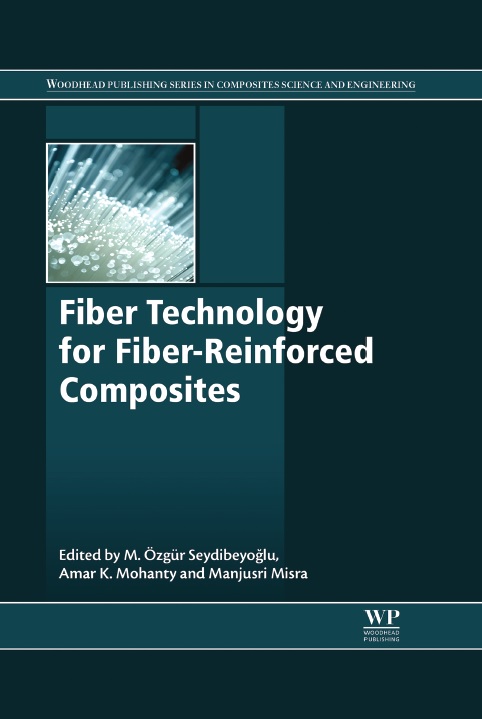Edited by Ozgur Seydibeyoglu, Amar Mohanty, Manjusri Misra

Contents
1 Introduction 1
M. O€zgu€r Seydibeyog˘lu, Amar K. Mohanty, Manjusri Misra
2 Mechanics of fiber composites 5
Levent Aydin, Hatice Sec¸il Artem, Erkan Oterkus, Omer Gundogdu,
Hamit Akbulut
2.1 Introduction 5
2.2 Mechanics of continuous fiber-reinforced composites 5
2.3 Mechanics of short fiber-reinforced composites 11
2.4 Mechanics of woven fabric composites 22
2.5 Interface mechanics in fiber-reinforced composites 26
2.6 Mechanics of curved composites 27
2.7 Strength failure theories 33
2.8 Dynamic behavior of composites 40
References 48
3 Fiber reinforced composites 51
Sec¸kin Erden, Kingsley Ho
3.1 Introduction 51
3.2 Materials (reinforcements, matrices, fiber/matrix adhesion) 56
3.3 Manufacturing 61
3.4 Characterization and testing 72
3.5 Fiber surface treatments 74
3.6 Conclusion 75
Acknowledgments 76
References 76
Further Reading 78
4 Surface modification of fibers and sizing operations 81
Esen Ozdogan, Tulay Gulumser, Asli Demir
4.1 Introduction and historical perspective 81
4.2 Physical methods 82
4.3 Chemical treatments 87
4.4 Biochemical treatments 92
4.5 Sizing 93
4.6 Conclusion 94
References 94
5 Glass fibers 99
Aref Cevahir
5.1 History of glass fiber 99
5.2 Glass fiber manufacturing 99
5.3 Types of glass fibers 103
5.4 Glass fiber products 107
5.5 Glass fiber sizing 109
5.6 Composite interphase 116
5.7 Conclusion 119
References 120
6 Carbon fibers 123
Kazim Acatay
6.1 Introduction 123
6.2 Different precursors for CF production 125
6.3 Carbonization processes 133
6.4 Recent developments and trends in CF technology 140
6.5 CF in polymer-matrix composites 141
6.6 Uses of CF in other matrices 148
6.7 Conclusion 150
References 150
7 Aramid fibers 153
Mustafa Ertekin
7.1 Introduction 153
7.2 Fiber production 153
7.3 Aramid fiber structure and properties 155
7.4 Fiber and product forms 158
7.5 Applications 158
7.6 Conclusion 164
7.7 Sources of further information 165
References 166
8 Basalt fibers 169
Volkan Acar, Ferit Cakir, Elif Alyamaç, M. O€zgu€r Seydibeyog˘lu
8.1 Introduction to basalt fibers 169
8.2 Preparation of basalt fibers 170
8.3 Structural properties 171
8.4 Basalt fiber-reinforced composites 173
8.5 Surface treatments of basalt fibers 175
8.6 Applications of basalt fiber 177
8.7 Conclusion 181
References 182
9 Ceramic fibers 187
Emre Yalamac¸, Mucahit Sutcu, Suat Bahar Basturk
9.1 Introduction 187
9.2 Oxide fibers 187
9.3 Nonoxide fibers 192
9.4 Production techniques of ceramic fibers 197
9.5 Application of ceramic fibers 203
References 204
10 Natural fibers 209
Ahmet C¸ ag˘rı Kılınç, Cenk Durmuşkahya, M. O€zgu€r Seydibeyog˘lu
10.1 Introduction to natural fibers 209
10.2 Plant fibers 212
10.3 Conclusion and future outlook 229
References 232
11 The use of biotechnology for green composites 237
Metehan Atagu€r, M. O€zgu€r Seydibeyog˘lu
11.1 Introduction to green composites 237
11.2 Natural polymer sources 240
11.3 Applications 244
11.4 Conclusion and future outlook 245
References 246
12 Nanofibers for fiber-reinforced composites 251
Nesrin Horzum, Nehir Arik, Yen Bach Truong
12.1 Introduction and historical perspective 251
12.2 Electrospinning 252
12.3 Carbon nanotubes/nanofibers 260
12.4 Cellulose nanofibers 262
12.5 Applications 264
References 265
Further Reading 274
13 The use of nanotechnology for fibre-reinforced polymer composites 277
Sibel Demiroglu, Vivekanandhan Singaravelu, M. O€zgu€r Seydibeyog˘lu,
Manjusri Misra, Amar K. Mohanty
13.1 Introduction 277
13.2 Nanotechnologies for matrix modification 279
13.3 Nanotechnologies for fibre modification 283
13.4 Future perspectives 291
13.5 Conclusions 293
Acknowledgments 293
References 293
14 Design and optimization of fiber composites 299
Levent Aydin, Hatice Sec¸il Artem
14.1 Introduction 299
14.2 Structural design 300
14.3 Material selection 300
14.4 Optimization 302
References 312
Further Reading 314
15 Concluding remarks and future outlook 317
M. O€zgu€r Seydibeyog˘lu, Amar K. Mohanty, Manjusri Misra
Index 319
Introduction:
The materials science and materials world are having a new paradigm, and many materials are now transforming to composite materials, replacing many metallic materials and ceramic materials. Metallic materials with well-known properties and well-known manufacturing techniques at an affordable price are still the first preference for the materials selection; however, in many applications, due to weight problems, corrosion, and fatigue issues, composites are becoming more and more important. The corrosion costs consume 3%–3.5% of the whole-world gross domestic product and contribute to many failures in the structural components [1]. Moreover, processing conditions for the composites and polymers are much more energy-efficient and more labor friendly compared to metallic materials. Ceramic materials with high-temperature performance and good strength are of great importance, but still, they lack the elasticity for many industrial applications.
In the materials’ area, the composites especially fiber-reinforced composites are becoming more desired specifically in the transportation industry where fuel consumption is of great importance, and reduced CO2 is another big issue. Composites are very critical for many automotive industries, aerospace, and marine applications. Carbon footprint and sustainability are the key factors in today’s world, and composites are the key materials for these problems. Especially in the last decade, the composite aerostructures have grown more than 100% with compounded annual growth rate (CAGR) of 11.1% [2].
As the world’s energy need is increasing, the composites are also very significant in the area of renewable energy sources like wind-turbine blades. Energy-storage tanks that can store natural gas, hydrogen, and many other critical gasses are of great importance for the composites. Restoring present pipelines with carbon composites has been also very critical for the gas-piping industry. A report in 2015 prepared by Global Wind Energy Council demonstrated the exponential growth of wind turbines [3]. It was reported that between the years of 2000 and 2015, there was 25-fold increase in the installed wind-turbine capacity [3].
Composites have been used in the construction industry since the foundation of steel reinforced concrete, but for certain areas, polymer composites with high flexibility of forming offer numerous advantages, especially in the area of reinforcing current buildings under the risk of earthquake attack.
Sporting goods such as golf, sailing boats, fishing roads, and new technology bikes are highly interesting engineering applications with very important new technological breakthroughs like the use of graphene in the bicycle frame being a superlight bicycle, which is very vital.
